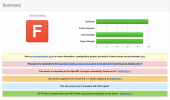Our website generates this error in Chrome and Edge:
ERR_SSL_PROTOCOL_ERROR
What's odd is that it's fine in Safari and Firefox. When I run the SSL test in sslshopper.com, I get that it's OK (screenshot attached) but when I run a test on ssllabs.com we get an F (2nd screenshot). I have other sites that fail the OpenSSL Padding Oracle Vulnerability test and get an F but they work fine. I'd like to address this but the critical difference seems to be that this test shows "This site works only in browsers with SNI support." while the sites that are fine don't show that. How do I fix it? I don't see anything that addresses this in Plesk.
Thanks in advance.
This site can’t provide a secure connection
blue-iceberg.com sent an invalid response.ERR_SSL_PROTOCOL_ERROR
What's odd is that it's fine in Safari and Firefox. When I run the SSL test in sslshopper.com, I get that it's OK (screenshot attached) but when I run a test on ssllabs.com we get an F (2nd screenshot). I have other sites that fail the OpenSSL Padding Oracle Vulnerability test and get an F but they work fine. I'd like to address this but the critical difference seems to be that this test shows "This site works only in browsers with SNI support." while the sites that are fine don't show that. How do I fix it? I don't see anything that addresses this in Plesk.
Thanks in advance.


